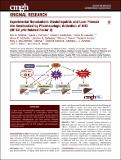Files in this item
Experimental nonalcoholic steatohepatitis and liver fibrosis are ameliorated by pharmacological activation of Nrf2 (NF-E2-related factor 2)
Item metadata
| dc.contributor.author | Sharma, Ritu S. | |
| dc.contributor.author | Harrison, David J. | |
| dc.contributor.author | Kisielewski, Dorothy | |
| dc.contributor.author | Cassidy, Diane M. | |
| dc.contributor.author | McNeilly, Alison D. | |
| dc.contributor.author | Gallagher, Jennifer R. | |
| dc.contributor.author | Walsh, Shaun V. | |
| dc.contributor.author | Honda, Tadashi | |
| dc.contributor.author | McCrimmon, Rory J. | |
| dc.contributor.author | Dinkova-Kostova, Albena T. | |
| dc.contributor.author | Ashford, Michael L.J. | |
| dc.contributor.author | Dillon, John F. | |
| dc.contributor.author | Hayes, John D. | |
| dc.date.accessioned | 2018-02-26T16:30:06Z | |
| dc.date.available | 2018-02-26T16:30:06Z | |
| dc.date.issued | 2017-12-13 | |
| dc.identifier | 251636943 | |
| dc.identifier | fdf975ca-1cfa-4daa-b33c-17bb2ea6fb57 | |
| dc.identifier | 85043604839 | |
| dc.identifier | 000428840500014 | |
| dc.identifier.citation | Sharma , R S , Harrison , D J , Kisielewski , D , Cassidy , D M , McNeilly , A D , Gallagher , J R , Walsh , S V , Honda , T , McCrimmon , R J , Dinkova-Kostova , A T , Ashford , M L J , Dillon , J F & Hayes , J D 2017 , ' Experimental nonalcoholic steatohepatitis and liver fibrosis are ameliorated by pharmacological activation of Nrf2 (NF-E2-related factor 2) ' , Cellular and Molecular Gastroenterology and Hepatology , vol. 5 , no. 3 , pp. 367-398 . https://doi.org/10.1016/j.jcmgh.2017.11.016 | en |
| dc.identifier.issn | 2352-345X | |
| dc.identifier.other | RIS: urn:1E3B330D33F9A577275B1C03B990914D | |
| dc.identifier.other | RIS: urn:1E3B330D33F9A577275B1C03B990914D | |
| dc.identifier.other | ORCID: /0000-0001-9041-9988/work/64034337 | |
| dc.identifier.uri | https://hdl.handle.net/10023/12789 | |
| dc.description | Funding: Supported by grants MR/J001465/1 (JDH, MLJA, JFD and RJMcC) and MR/N009851/1 (JDH, MLJA, ATD-K and DJH) from the Medical Research Council of the UK and grants from Stony Brook Foundation and Reata Pharmaceuticals, Inc. (TH) | en |
| dc.description.abstract | Background & Aims: Nonalcoholic steatohepatitis (NASH) is associated with oxidative stress. We surmised that pharmacological activation of NF-E2 p45-related factor 2 (Nrf2) using the acetylenic tricyclic bis(cyano-enone) TBE-31 would suppress NASH because Nrf2 is a transcriptional master regulator of intracellular redox homeostasis. Methods: Nrf2+/+ and Nrf2-/- C57BL/6 mice were fed a high-fat plus fructose (HFFr) or regular chow (RC) diet for 16 weeks or 30 weeks, and then treated for the final 6 weeks, whilst still being fed the same HFFr or RC diets, with either TBE-31 or DMSO vehicle control. Measures of whole body glucose homeostasis, histological assessment of liver, and biochemical and molecular measurements of steatosis, endoplasmic reticulum (ER) stress, inflammation, apoptosis, fibrosis and oxidative stress were performed in livers from these animals. Results: TBE-31−treatment reversed insulin resistance in HFFr-fed wild-type mice, but not in HFFr-fed Nrf2-null mice. TBE-31−treatment of HFFr-fed wild-type mice substantially decreased liver steatosis and expression of lipid synthesis genes, whilst increasing hepatic expression of fatty acid oxidation and lipoprotein assembly genes. Also, TBE-31−treatment decreased ER stress, expression of inflammation genes, and markers of apoptosis, fibrosis and oxidative stress in the livers of HFFr-fed wild-type mice. By comparison, TBE-31 did not decrease steatosis, ER stress, lipogenesis, inflammation, fibrosis or oxidative stress in livers of HFFr-fed Nrf2-null mice. Conclusions: Pharmacological activation of Nrf2 in mice that had already been rendered obese and insulin resistant reversed insulin resistance, suppressed hepatic steatosis, and mitigated against NASH and liver fibrosis, effects that we principally attribute to inhibition of ER, inflammatory and oxidative stress. | |
| dc.format.extent | 32 | |
| dc.format.extent | 8800162 | |
| dc.language.iso | eng | |
| dc.relation.ispartof | Cellular and Molecular Gastroenterology and Hepatology | en |
| dc.subject | NASH | en |
| dc.subject | Nrf2 | en |
| dc.subject | TBE-31 | en |
| dc.subject | RM Therapeutics. Pharmacology | en |
| dc.subject | QH301 Biology | en |
| dc.subject | NDAS | en |
| dc.subject.lcc | RM | en |
| dc.subject.lcc | QH301 | en |
| dc.title | Experimental nonalcoholic steatohepatitis and liver fibrosis are ameliorated by pharmacological activation of Nrf2 (NF-E2-related factor 2) | en |
| dc.type | Journal article | en |
| dc.contributor.sponsor | Medical Research Council | en |
| dc.contributor.institution | University of St Andrews. School of Medicine | en |
| dc.contributor.institution | University of St Andrews. Cellular Medicine Division | en |
| dc.identifier.doi | https://doi.org/10.1016/j.jcmgh.2017.11.016 | |
| dc.description.status | Peer reviewed | en |
| dc.identifier.grantnumber | MR/N009851/1 | en |
This item appears in the following Collection(s)
Items in the St Andrews Research Repository are protected by copyright, with all rights reserved, unless otherwise indicated.

